|
|
The MGA has conked out in traffic a few times due to fuel vaporization.
The only way to cure the problem was to let the car cool down with the
bonnet open for half an hour, then she'd start and run perfectly.
Yesterday she broke down just at the top of a ramp in a multi storey
car park. The fuel vaporisation needed some attention.
Much later I found the car was running retarded which resulted in the
exhaust manifold becoming hotter than it should have been. But the heatshields
on this page helped a lot too.
|
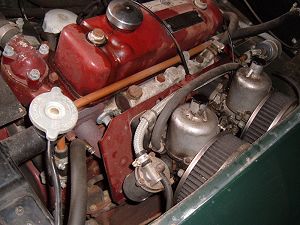 |
The MGA engine bay has it's issues. Not least the carburetor
float chambers sit only an inch from the exhaust manifold, and
the steel heat shield is painted in a dark colour which is poor
for reflecting heat. Also the engine bay is very enclosed so air
flow through the engine bay is poor and heat can build up.
My plan was to replace the old steel heatshield with a shiny
aluminium one that might reflect a bit of heat.
|
| |
|
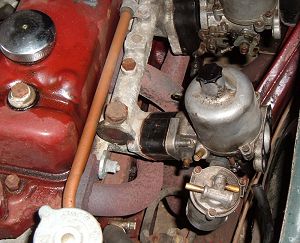 |
You can see the proximity of the float chamber to the exhaust
with the heatshield removed.
Modern car practice is to have heatshields right up against the
exhaust manifolds, the idea being that heat is taken down the
exhaust and released under the floor rather than in the engine
bay.
But enclosing the exhaust manifold can increase the temperature
towards the ignition point for oil and petrol, so wouldn't necessarily
be a sensible option for a car with a track record of leaking
both of these fluids around the engine bay. |
| |
|
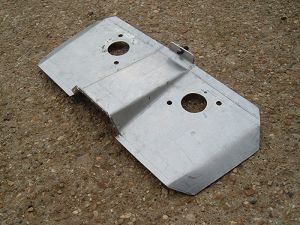 |
I made the new heatshield slightly larger than the old one,
and positioned it slightly closer to the exhaust.
The old heat shield made a good template for the hole positions
which were drilled after all the folding and bending had been
finished. I've also included an adjustable throttle linkage much
like the one my bicycle brakes used to have. |
| |
|
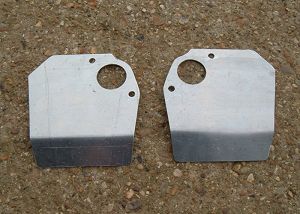 |
I quite enjoyed making the heatshield so decided to knock a
couple more up. The cunning idea was to fit the main heatshield
on the engine side of the carburetor insulating blocks, and these
further heatshields on the carb side to shield the float chambers.
|
| |
|
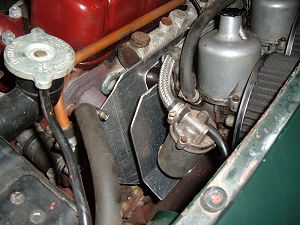 |
Here the heatshields are installed, and I thought I'd test
them out with a thermocouple.
After an enthusuiastic 5 mile drive and a long idle I opened
up the bonnet. The heatshield closest to the exhaust was quite
hot to the touch. The second heatshield was much cooler, and a
the float chambers were 5 degrees C cooler than that.
Success - however well the new main heatshield is performing,
the secondary ones are reducing fuel temperatures by 5 degrees
C. That's got to help.
|
| |
|
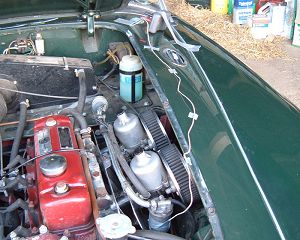 |
I thought I'd do some measurements. Here's a photo of the thermocouple
installation. It's a cheap one that came with the volt meter that's
taped to the wing. I could see the readings while driving.
The outside temperature was about 15 degrees C, and the float
chamber stayed at around 35 degrees C when driving on the open
road. After some stop start city driving the float chamber temperature
slowly increased. At 45 degrees C the idle speed started to fall
a little. The temperature rose to 49 degrees before I got bored
and decided to investigate.
Turns out everything in the engine bay was at that temperature,
and of course it would be - there's a great big radiator at the
front heating everything up.
|
| |
|
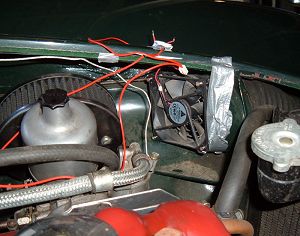 |
I fitted a manual switch to the engine cooling fan to see whether
a constant airflow would help, but it didn't make any difference
to the fuel temperature. I did wire the fan from live rather than
ignition so the fan can cool the engine down while I'm buying
my groceries, hopefully getting around the embarrassing hot starting
problems.
The one thing that did help was a little fan from a computer
directed from the cold air vents to the float chambers. That's
my emergency backup plan, but I'll keep the car as it is for now,
as I suspect the heatshields were the cause of the problem. Although
I really wish I'd measured float chamber temperatures before I
started.
The float chambers must have been reaching the boiling point
of petrol (around 100 degrees C), so if I'm only seeing 50 degrees
now then I've hopefully cured the problem.
|
|
Update: The changes to the heatshield have eliminated fuel vaporisation as
a problem, but I later developed a hot
running problem, mostly down to ignition leads and rotor arm.
Back to: Home > MGA
Restoration and Adventures
